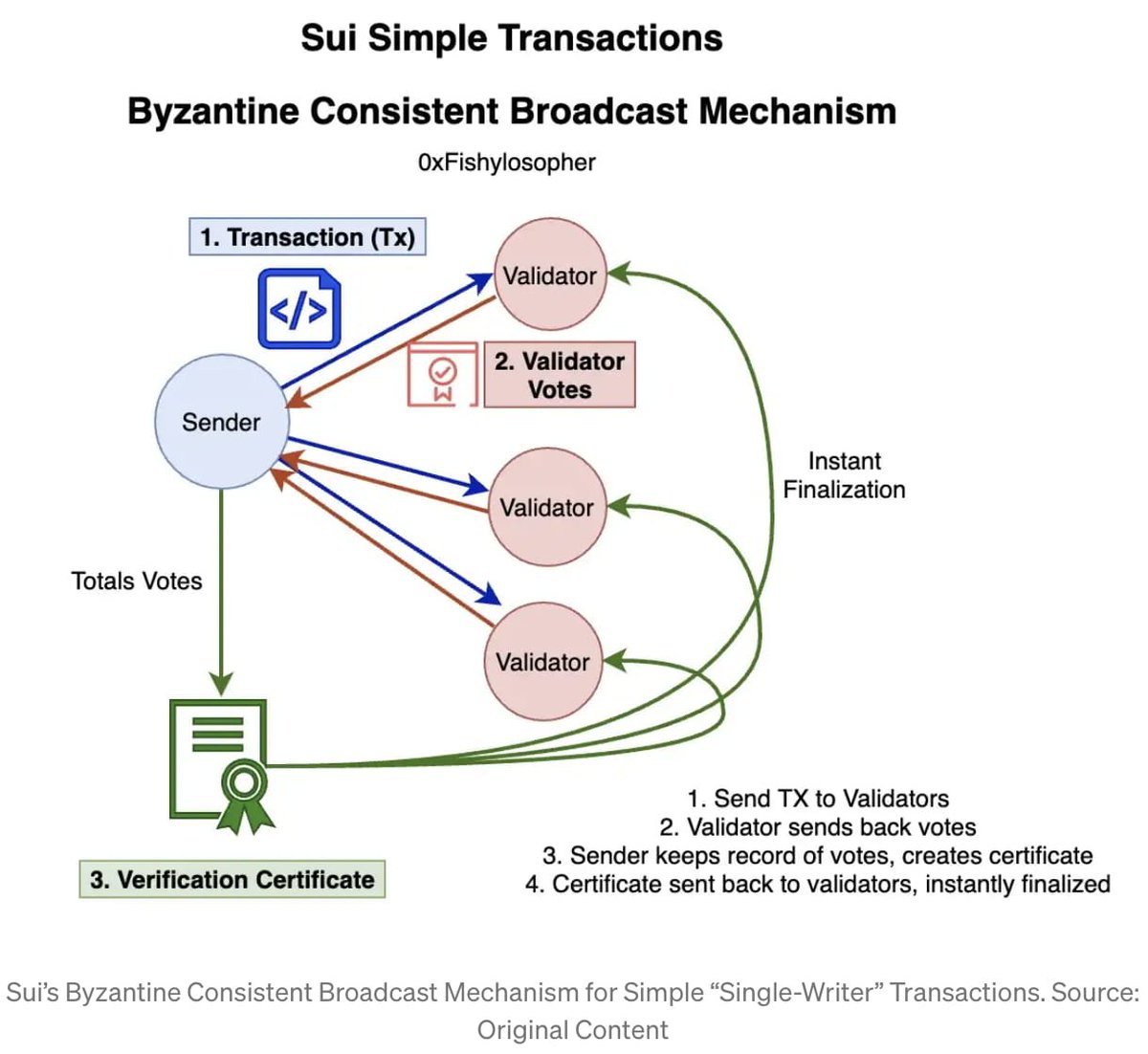0/ @SuiNetwork is valued at USD 2 BILLION & is close to launching a mainnet able of processing >100'000 TPS 🚀
NO AIRDROP but the $SUI TSUNAMI is still coming and YOU should get ready to surf it in 2023 🌊🏄♂️
so time to DYOR 📚🔍
ALPHA-packed GIGA research 🧵 on #Sui (0/47) 💧
NO AIRDROP but the $SUI TSUNAMI is still coming and YOU should get ready to surf it in 2023 🌊🏄♂️
so time to DYOR 📚🔍
ALPHA-packed GIGA research 🧵 on #Sui (0/47) 💧

1/ contents:
🖥️ Move Language (2-8)
🤝 Consensus Mechanism (9-16)
⛓ Parallel Execution (17-20
💾 Data Storage Fund (21-23)
⛽️ Gas Pricing Mechanism (24-26)
🪙 Tokenomics (27-32)
⚖️ Governance (33)
💼 Team & Funding (34-38)
🌐 Ecosystem (39-44)
🔍 Conclusion (45-47)
🖥️ Move Language (2-8)
🤝 Consensus Mechanism (9-16)
⛓ Parallel Execution (17-20
💾 Data Storage Fund (21-23)
⛽️ Gas Pricing Mechanism (24-26)
🪙 Tokenomics (27-32)
⚖️ Governance (33)
💼 Team & Funding (34-38)
🌐 Ecosystem (39-44)
🔍 Conclusion (45-47)
2/ 🖥️ Move Language
#Move is a programming language developed by #Sui that provides comprehensive security for smart contracts at several levels:
🛡 Language design
🛡 Virtual machine
🛡 Contract invocation
🛡 Contract execution
#Move is a programming language developed by #Sui that provides comprehensive security for smart contracts at several levels:
🛡 Language design
🛡 Virtual machine
🛡 Contract invocation
🛡 Contract execution

3/ #Move's resource type distinguishes digital assets from other data & combines strong data abstraction features, ensuring assets are not created, copied, or discarded arbitrarily. This significantly increases security
4/ #Move supports only static calls, allowing all contract execution paths to be determined at compile time. This enables full analysis & verification, revealing potential security vulnerabilities in advance and reducing the probability of system downtime
5/ #Move introduces formal verification tools, greatly reducing the cost of manual code security audits. It also aims to enable parallel processing, improving system operation efficiency
6/ #Move is developer-friendly, lowering the security threshold for development so that developers can focus on business logic. The switching cost for developers experienced in #Rust and #Solidity is relatively low
7/ While both @Aptos_Network and @SuiNetwork leverage the #Move language, they employ slightly different models. #Aptos uses the original Move language created by the #Diem team, while Sui uses their alternative version known as "Sui Move"
8/ if you want to check out the other #Move-based chain @Aptos_Network that is making big waves, check out my thread linked below 👇
https://twitter.com/expctchaos/status/1646975899617878020
9/ 🤝 Consensus Mechanism
@SuiNetwork relies on Delegated Proof-of-Stake (dPoS) to determine validators who process transactions. Validators' share of total stake determines their share of voting power for transaction processing
@SuiNetwork relies on Delegated Proof-of-Stake (dPoS) to determine validators who process transactions. Validators' share of total stake determines their share of voting power for transaction processing
10/ within each epoch, operations are processed by a fixed set of validators, each with a specific amount of stake delegated from $SUI token holders. Delegating $SUI locks tokens for the entire epoch & delegates receive a portion of the stake rewards at epoch close
11/ @SuiNetwork's object-centric design allows validators to execute transactions using a causal-ordering approach. For transactions on owned objects, total ordering of transactions isn't required, making them unidirectional and consensus-free 

12/ shared object transactions, however, do go through consensus for ordering agreement among nodes after validation. This unique two-layered consensus module used by #Sui, known as Narwhal & Bullshark, was developed by researchers at @Mysten_Labs and @Aptos_Network
13/ #Narwhal ensures data availability submitted to consensus, while Bullshark (or Tusk) agrees on a specific ordering of this data
14/ #Narwhal is a Mempool module based on a scaled primary-worker architecture, separating roles and requirements of the mempool across different players:
⚙️ cryptographic proofs of data availability at a primary
⚙️ disk I/O and networking requirements across several worker
⚙️ cryptographic proofs of data availability at a primary
⚙️ disk I/O and networking requirements across several worker
15/ additionally, the #Narwhal mempool uses a structured graph data structure (DAG) for traversing data. This scaled, role-based #DAG architecture offers zero-message networking overhead design on the consensus 

16/ after Narwhal, the validated certificates get ordered through the consensus among the validator nodes, a process called Bullshark or Tusk in the #Sui Consensus Engine. In August 2022, #Bullshark replaced #Tusk as the default for reduced latency and support for fairness
17/ ⛓ Parallel Execution
as mentioned, @SuiNetwork eliminates consensus for many tx types altogether. Simple transfers of tokens by their owner are confirmed virtually instantly through a process called Fast Pay, which is a Byzantine Consistent Broadcast (BCB) based algorithm
as mentioned, @SuiNetwork eliminates consensus for many tx types altogether. Simple transfers of tokens by their owner are confirmed virtually instantly through a process called Fast Pay, which is a Byzantine Consistent Broadcast (BCB) based algorithm

18/ #FastPay enables the #Sui network to achieve very high TPS (transactions per second) through a minimalized peer review process among validators. In a 20-node validator setting, the network can achieve ~80,000 TPS (100ms)
19/ this approach positions @SuiNetwork as a L1 solution for specific use cases where dApps generate large numbers of simple transactions, require low-latency confirmations, and are less concerned about decentralization (for example #NFTs & #gaming)
20/ so in summary, @SuiNetwork uses parallel execution for simple transactions without dependencies, while using a BFT consensus for executing more complicated transactions sequentially in a precise order
21/ 📚 Data Storage Fund
@SuiNetwork's economic design includes a storage fund that redistributes past transaction fees to future validators, addressing the intertemporal challenge of funding data storage and preventing negative network externalities.
@SuiNetwork's economic design includes a storage fund that redistributes past transaction fees to future validators, addressing the intertemporal challenge of funding data storage and preventing negative network externalities.

22/ the storage fund, counted as part of the total stake, is used to adjust the share of staking rewards distributed to validators relative to $SUI delegators. This ensures the fund is never at risk of depletion, making it a sustainable long-term economic mechanism
23/ @SuiNetwork also introduces a "deletion option" for users to receive a storage fee rebate when deleting previously stored on-chain data (e.g., #NFT metadata), encouraging efficient data management
24/ ⛽️ Gas Pricing Mechanism
#Sui's gas-pricing mechanism delivers low, predictable transaction fees to users and incentivizes validators to optimize their transaction processing operations, preventing denial of service attacks
#Sui's gas-pricing mechanism delivers low, predictable transaction fees to users and incentivizes validators to optimize their transaction processing operations, preventing denial of service attacks
25/ by setting a network-wide reference price for gas fees at the start of each epoch, @SuiNetwork users can submit transactions without worrying about forecasting market gas prices. This also rewards good validator behaviour, aligning incentives among network participants
26/ a unique aspect of @SuiNetwork's gas pricing is the separation of fees for transaction execution and data storage, providing a more transparent cost structure for users
27/ 🪙 Tokenomics
$SUI, @SuiNetwork's native token, has a capped supply of 10 billion tokens. It serves four purposes:
✅ staking for PoS
✅ gas fee payment
✅ underpinning the Sui economy
✅ participating in on-chain voting
$SUI, @SuiNetwork's native token, has a capped supply of 10 billion tokens. It serves four purposes:
✅ staking for PoS
✅ gas fee payment
✅ underpinning the Sui economy
✅ participating in on-chain voting
28/ $SUI tokens are distributed as follows:
👥 50% community reserve
👨💻 20% early contributors
💰 14% investors
🏦 10% @Mysten_Labs treasury
🪂 6% community access program & app testers
👥 50% community reserve
👨💻 20% early contributors
💰 14% investors
🏦 10% @Mysten_Labs treasury
🪂 6% community access program & app testers

29/ since the $SUI token is available in finite supply, the same amount of tokens will need to be used across more economic activities in the long run
30/ in addition, the $SUI storage fund’s presence creates important monetary dynamics in that higher on-chain data requirements translate into a larger storage fund, reducing the amount of $SUI in circulation 

31/ the fact that opposed to $OP, $APT or $ARB, @SuiNetwork has decided to NOT have an airdrop, has caused a lot of disappointment among the $SUI community
community can participate through a kind of early adopter sale & buy $SUI at a discount
community can participate through a kind of early adopter sale & buy $SUI at a discount
https://twitter.com/its_airdrop/status/1647107602847870978
33/ ⚖️ Governance
Protocol upgrades and other @SuiNetwork governance changes are passed through on-chain voting proposals, with $SUI token holders actively participating in the decision-making process
Protocol upgrades and other @SuiNetwork governance changes are passed through on-chain voting proposals, with $SUI token holders actively participating in the decision-making process
34/ 💼 Team & Funding
Sui was founded by @Mysten_Labs, whose co-founders and employees previously worked on @DiemAssociation and the #Move programming language
Sui was founded by @Mysten_Labs, whose co-founders and employees previously worked on @DiemAssociation and the #Move programming language

35/ team 👇
@EvanWeb3 (Co-Founder, CEO)
@EmanAbio (Co-Founder, CPO)
@b1ackd0g (Co-Founder, CTO)
@GDanezis (Co-Founder, Chief Scientist)
@kostascrypto (Co-Founder, Chief Cryptographer)
@trfiala (Head of Engineering)
@ed_snook (Director of People)
Kevin Boon (Chief Legal Officer)
@EvanWeb3 (Co-Founder, CEO)
@EmanAbio (Co-Founder, CPO)
@b1ackd0g (Co-Founder, CTO)
@GDanezis (Co-Founder, Chief Scientist)
@kostascrypto (Co-Founder, Chief Cryptographer)
@trfiala (Head of Engineering)
@ed_snook (Director of People)
Kevin Boon (Chief Legal Officer)

36/ team (cont'd) 👇
@EvilleAlly (Head of Operations)
@alonsodegortari (Head Economist)
@seannyboy126 (Head of Talent)
Janet Wu (Director of Product)
Dimitri Perelman (Director of Engineering)
@EvilleAlly (Head of Operations)
@alonsodegortari (Head Economist)
@seannyboy126 (Head of Talent)
Janet Wu (Director of Product)
Dimitri Perelman (Director of Engineering)

37/ @Mysten_Labs raised a $36M Series A in Dec 2021 led by @a16z and a $300M Series B in Sep 2022, led by #FTX Ventures at a valuation of USD 2 billion 

38/ other notable investors include:
💰 @BinanceLabs
💰 @coinbase
💰 @arrington
💰 @ElectricCapital
💰 @Redpoint
💰 @SinoGlobalCap
💰 @BixinVentures
💰 @circle
💰 @jump_
💰 @FTI_Global
💰 @TheSpartanGroup
💰 @BinanceLabs
💰 @coinbase
💰 @arrington
💰 @ElectricCapital
💰 @Redpoint
💰 @SinoGlobalCap
💰 @BixinVentures
💰 @circle
💰 @jump_
💰 @FTI_Global
💰 @TheSpartanGroup

39/ 🌐 Ecosystem
even though @SuiNetwork is not on mainnet yet, the #Sui ecosystem already hosts a broad variety of applications & infrastructure providers
let's dive in 💧
even though @SuiNetwork is not on mainnet yet, the #Sui ecosystem already hosts a broad variety of applications & infrastructure providers
let's dive in 💧

40/ 🔒 Wallets
🔹 @WaveWalletApp
🔹 @suiet_wallet
🔹 @EthosWalletXYZ
🔹 @FewchaWallet
🖼 NFT Marketplaces
🔹 @BlueMove_OA
🔹 @STARSPACEio
🔹 @Clutchy_io
🔹 @GallerySui
🔹 @Flame_Protocol
🔹 @WaveWalletApp
🔹 @suiet_wallet
🔹 @EthosWalletXYZ
🔹 @FewchaWallet
🖼 NFT Marketplaces
🔹 @BlueMove_OA
🔹 @STARSPACEio
🔹 @Clutchy_io
🔹 @GallerySui
🔹 @Flame_Protocol
41/ 🎮 GameFi
🔹 @RushdownRevolt
🔹 @gaggle_fun
🔹 @ggd_game
🔹 @ggslayer_game
🔹 @plasmaversexyz
🔹 @TalofaGames
🔹 @LuckyKatStudios
🔹 @TrialXtreme
🔹 @tocen__
🔹 @SugarKingdomNFT
🔹 @MightySquadGame
🔹 @AbyssWorldHQ
🔹 @RushdownRevolt
🔹 @gaggle_fun
🔹 @ggd_game
🔹 @ggslayer_game
🔹 @plasmaversexyz
🔹 @TalofaGames
🔹 @LuckyKatStudios
🔹 @TrialXtreme
🔹 @tocen__
🔹 @SugarKingdomNFT
🔹 @MightySquadGame
🔹 @AbyssWorldHQ

42/ 🔄 DEX & Aggregator
🔹 @joinMovEX
🔹 @Turbos_finance
🔹 @Suidex_io
🔹 @CetusProtocol
🔹 @suiswap_app
🔹 @bayswap
🔹 @umi_protocol
🚀 Launchpad
🔹@SuiPadxyz
🔹@Sui_start
💸 Other DeFi
🔹 @OmniBTC
🔹 @ArayaFinance
🔹 @OnchainTrade
🔹 @TypusFinance
🔹 @abelfinance
🔹 @joinMovEX
🔹 @Turbos_finance
🔹 @Suidex_io
🔹 @CetusProtocol
🔹 @suiswap_app
🔹 @bayswap
🔹 @umi_protocol
🚀 Launchpad
🔹@SuiPadxyz
🔹@Sui_start
💸 Other DeFi
🔹 @OmniBTC
🔹 @ArayaFinance
🔹 @OnchainTrade
🔹 @TypusFinance
🔹 @abelfinance

43/ 🌐 SocialFi
🔹 @ComingChatApp
🔹 @sowork_
🔹 @Peeranhaio
🌉 Bridges
🔹 @axelarcore
🔹 @wormholecrypto
⚙️ Tools & Infra
🔹 @MetaOraclepro
🔹 @ShinamiCorp
🔹 @latitudesh
🔹 @chainx_org
🔹 @PythNetwork
🔹 @Scale3Labs
🔹 @SupraOracles
🔹 @SuiNames
🔹 @SNSstork
🔹 @SuiNSdapp
🔹 @ComingChatApp
🔹 @sowork_
🔹 @Peeranhaio
🌉 Bridges
🔹 @axelarcore
🔹 @wormholecrypto
⚙️ Tools & Infra
🔹 @MetaOraclepro
🔹 @ShinamiCorp
🔹 @latitudesh
🔹 @chainx_org
🔹 @PythNetwork
🔹 @Scale3Labs
🔹 @SupraOracles
🔹 @SuiNames
🔹 @SNSstork
🔹 @SuiNSdapp
44/ 🎨 NFT Collections
🔹 @SuiMo_NFT
🔹 @theSuiPunks
🔹 @Sui_Birds
🔹 @eggworld_sui
🔹 @DinoSuiNFT
🔹 @HungryKitties
🔹 @SuiDuckz
🔹 @Sui_BoltApeYC
🔹 @SuiGoziKong
🔹 @suivivors
🔹 @OctopusSui
🔹 @OccultNFT
🔹 @SuiOkayBears
🔹 @HorsesAlpha
🔹 @suiskulls
🔹 @SuiCatsNFT
🔹 @SuiMo_NFT
🔹 @theSuiPunks
🔹 @Sui_Birds
🔹 @eggworld_sui
🔹 @DinoSuiNFT
🔹 @HungryKitties
🔹 @SuiDuckz
🔹 @Sui_BoltApeYC
🔹 @SuiGoziKong
🔹 @suivivors
🔹 @OctopusSui
🔹 @OccultNFT
🔹 @SuiOkayBears
🔹 @HorsesAlpha
🔹 @suiskulls
🔹 @SuiCatsNFT

45/ 🔍 Conclusion
@SuiNetwork's innovative approach to consensus, parallel execution, and data storage offers a high-performance, low-latency solution for various use cases
@SuiNetwork's innovative approach to consensus, parallel execution, and data storage offers a high-performance, low-latency solution for various use cases
46/ the special treatment of simple transactions (skip consensus) and the high degree of stability & predictability with regards to gas fees makes the @SuiNetwork L1 especially well-suited for applications in the #NFT, #GameFi or #SocialFi space
47/ and with a growing ecosystem, lots of funding and a strong team, $SUI is well-positioned for future growth. However, the recent decision not to launch an airdrop has caused a lot of discontent in the community
an airdrop could have also been a big adoption driver
an airdrop could have also been a big adoption driver
if you want to check out another #Move-based high-performance network, have a look at my thread on @Aptos_Network 👀👇
https://twitter.com/expctchaos/status/1646975899617878020
to stay updated on the #Sui Ecosystem, I recommend following these accounts 👇
@SuiFoundation
@Mysten_Labs
@SuiNewsDaily
@Sui_Station
@SuiEcoNews
@SuiEcosystem
@Sui_insiders
@SuiWatcher
@SuiDailyTK
@suipiens
@sui_insider_TIG
@SuiWhale
@kohkim
@ThounyBreasty
@SuiInsights
@SuiFoundation
@Mysten_Labs
@SuiNewsDaily
@Sui_Station
@SuiEcoNews
@SuiEcosystem
@Sui_insiders
@SuiWatcher
@SuiDailyTK
@suipiens
@sui_insider_TIG
@SuiWhale
@kohkim
@ThounyBreasty
@SuiInsights
also tagging a few frens that might want to check this out 🫶
@kunalgoel
@redvelvetzip
@hmalviya9
@Louround_
@AurumMege
@polkadotknight
@ksmchaos
@0xSalazar
@ShivanshuMadan
@0xJh4tM
@Windows95Man_
@kunalgoel
@redvelvetzip
@hmalviya9
@Louround_
@AurumMege
@polkadotknight
@ksmchaos
@0xSalazar
@ShivanshuMadan
@0xJh4tM
@Windows95Man_
if you want to learn more about @SuiNetwork:
🔗 Check out the docs: sui.network
📚 Read the Sui whitepaper: sui.network/whitepaper.pdf
🌐 Join the Sui community: discord.gg/sui
🔗 Check out the docs: sui.network
📚 Read the Sui whitepaper: sui.network/whitepaper.pdf
🌐 Join the Sui community: discord.gg/sui
• • •
Missing some Tweet in this thread? You can try to
force a refresh

 Read on Twitter
Read on Twitter









